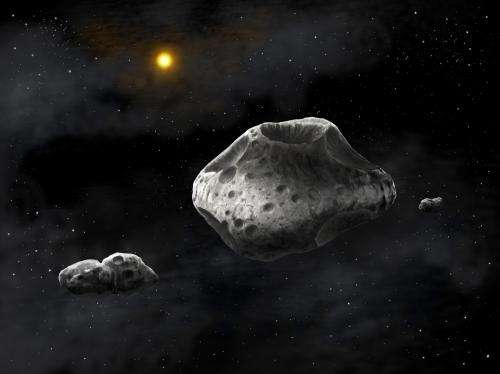New insights on the origin of the triple asteroid system (87) Sylvia

Combining observations from the world's largest telescopes with those from smaller instruments used by amateur astronomers, a team of scientists has discovered that the large main-belt asteroid (87) Sylvia has a complex interior. This has been deduced by using the motions of the two moons orbiting the main asteroid as probes of the object's density distribution. The complex structure is probably linked to the way the multiple system was formed.
The findings were announced last year at the 45th annual Division of Planetary Sciences meeting in Denver, Colorado and were published last month in the journal Icarus.
The asteroid (87) Sylvia is the first known to have two moons. One moon was discovered in 2001, and the second was found in 2005 by a team led by Franck Marchis, senior research scientist at the Carl Sagan Center of the SETI Institute. Since then, the team has continued to make new observations of the system using 8 to 10 m-class telescopes, including those at the Keck Observatory, the European Southern Observatory, and Gemini North.
An artist's rendition of the triple system showing the large 270-km asteroid Sylvia surrounded by its two moons – Romulus and Remus – gives a pictorial representation of this intriguing triple system.
The differentiated interior of the asteroid is shown in a cutaway diagram. The primary asteroid may have a dense, regularly-shaped core, surrounding by fluffy or fractured material. The outer moon, named Romulus, is known to be strongly elongated, possibly having two lobes, as suggested by a recently observed occultation recorded by amateur astronomers.
"Combined observations from small and large telescopes provide a unique opportunity to understand the nature of this complex and enigmatic triple asteroid system," Marchis said. "Thanks to the presence of these moons, we can constrain the density and interior structure of an asteroid, without the need for a spacecraft's visit. Knowledge of the internal structure of asteroids is key to understanding how the planets of our solar system formed."
The article "Physical and dynamical properties of the main belt triple Asteroid (87) Sylvia, published last month in Icarus, is co-authored by J. Berthier, F. Vachier, B. Carry from IMCCE-Obs de Paris, J. Durech from Charles University, Prague, and F. Marchis from the SETI Institute and Obs. de Paris.
More information: Berthier, J., F. Vachier, F. Marchis, J. Ďurech, and B. Carry. 2014. "Physical and Dynamical Properties of the Main Belt Triple Asteroid (87) Sylvia." Icarus 239 (September): 118–30. DOI: 10.1016/j.icarus.2014.05.046.
Journal information: Icarus
Provided by SETI Institute




















